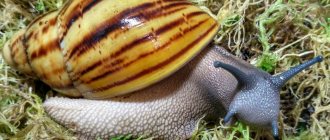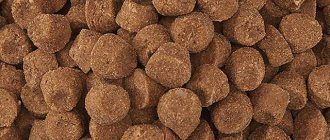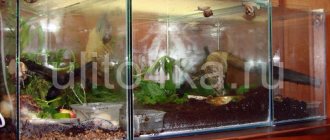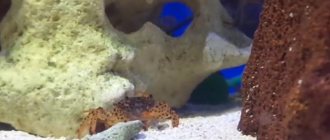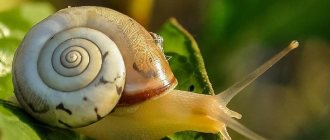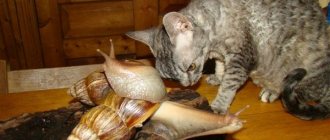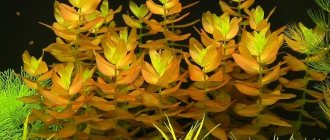Snails are sedentary gastropods. Their habitat can be both land and water. In the wild, these representatives of the fauna very rarely live to “old age”, due to the large number of enemies and rapidly changing environmental conditions. However, domestic species can live for several years. To prolong the life of your pets, it is important to properly care for your snails.
The habitat of snails can be both land and water.
The main rules for communicating with a snail
There are several rules that must be strictly observed when communicating with Achatina.
- The first rule: communication with Achatina must be started with clean, wet hands. Hands must be washed with soap and rinsed thoroughly so that no soap marks remain on your hands. Also, there should be no traces of cream, aromatic oils, etc. on your hands.
- The second rule: do not touch or pull the sink with your hands. Achatina sticks to the walls of the home very tightly. If you try to tear it off by taking it by the shell, the snail may remain on the wall, and its shell in your hands. This is practically death for the animal. Therefore, before picking up your pet, you need to spray it with a little water, and use a wet finger to touch its face and the front of its leg. Achatina will crawl onto a wet hand and unstick the rest of the leg from the wall of the aquarium. Also, you should not touch the growth, as it can easily be damaged. Then the further formation of the shell will occur with disturbances, it will become covered with scars.
- Third rule: you cannot forcibly pull Achatina out of the shell, as you can damage not only its house, but also Achatina’s body.
- Fourth rule: children should not be allowed to play with snails without supervision.
- Fifth rule: after interacting with your pet, be sure to wash your hands with soap. All gastropods are carriers of parasites. You can get infected through dirty hands. This is especially true for children.
How to create a comfortable environment for a snail
Achatina plants do not need bright light to function. The scorching sun is destructive for them. These are nocturnal inhabitants. The main thing is that they feel the change of day and night. Therefore, it is not recommended to keep pets on the windowsill, but a coffee table is a great place. During the day, Achatina can be in the ground or under a leaf, and in the evening it will begin to crawl, eat, and explore the surrounding space with interest.
They also need a comfortable, spacious, moist home with clean bedding. The soil is poured onto the bottom in a thick layer - up to 12 cm. It must be sterile, for this it is:
- washed under running water,
- calcined in the oven at 200°C for 7 - 8 minutes;
- cool down.
The larger the animal, the thicker the layer of soil is needed, since it will bury itself entirely in it.
Choosing a container for housing
Before you get an exotic mollusk, you need to prepare a comfortable habitat for it, bringing it closer to natural conditions. You should not keep your pet in a jar or small plastic container. For the normal life of one adult, an aquarium or container volume of 10 to 15 liters is required. Kids, on the contrary, need a small aquarium, as it will be difficult for them to get to food.
In the photo: Terrarium
For snails you can buy:
- aquarium;
- terrarium;
- Plastic container.
There are certain requirements for such containers:
- they must have smooth transparent walls;
- do not use convex containers (round aquarium, jar, etc.);
- You cannot use cardboard, wooden or metal containers.
It is also necessary to arrange a lid with holes so that the Achatina cannot crawl around the apartment or fall and damage the sink. If there is a cat or dog living at home, it is necessary to install the container so that the animals cannot reach its inhabitants.
You cannot decorate the container with hard or sharp objects, which could damage the shell. For drinking bowls, you can take ordinary nylon lids from jars. You can equip your pet with a small swimming pool with low sides so that the animals do not choke.
✅ Terrarium
Suitable terrariums can be purchased at any pet store. Such pleasure is not cheap. They are made from glass or plastic. The price of the product will depend on this. Glass terrariums are not very durable, but they are cheaper than plastic ones. They come in various sizes and shapes. It is best to choose a horizontal terrarium as it is more stable. But the main advantage of such a container is that it is sold with a lid with special holes. Also included is a thermometer. It will help control the temperature.
✅ Aquarium
An aquarium of 15 - 40 liters is suitable for breeding Achatina. This will be enough for two or three large individuals.
For the safety of the inhabitants, the aquarium is covered with a lid made of plexiglass or thick glass with holes for air.
The main disadvantages of an aquarium:
- fragility;
- weighs a lot;
- it is difficult to make holes in the glass lid;
- The glass lid causes inconvenience in caring for animals.
✅ Plastic container
Such a food-grade plastic container with a lid is the best option for Achatina:
- even the largest container weighs little and is easy to clean;
- it is easy to make the necessary holes in the plastic cover;
- the container has handles that help you move the container from place to place;
- the most suitable container for beginner snail breeders.
Popular types for home keeping
Land snails are divided into dozens of species for home keeping, but the leading positions are occupied by African individuals - Achatina. This pet has the largest dimensions, and to keep one specimen, a tank of 10 liters or more is required. However, we will tell you about all the types suitable for maintaining a home in order.
Brigade!
- Achatina. There are reticulita, fulica, immaculata, albopictu and other subspecies. All of them are kept as pets. Achatina is of African origin and easily learns daily routines. For example, she can be taught to eat food on a schedule without any problems.
- The grape snail is the second most popular. It is not as large as the previous version. It can reach 5-6 cm in length and 3-5 cm in width. It comes in a variety of colors and is not difficult to maintain.
- Arhahatina is the closest relative of Achatina. She also comes from Africa, but is considered simpler in appearance. Its shell has a rounded outline, while Achatina has a pointed cone. Arhahatina is also a large representative of mollusks, but at the same time unpretentious. One of the largest representatives among the archahatines is marginalata. Dimensions can exceed 14-16 cm. Color varies, like Achatina.
- Garden snail. This species is not sold in pet stores, but lives throughout Russia. The shellfish can be brought from the garden. By the way, the grape snail is also found among garden snails. Garden snails are considered long-lived. Some specimens can last up to 14-15 years, and the average lifespan is about 7-8 years.
Soil for Achatina
Preparing the soil for Achatina is a particularly important task. Forest, garden or vegetable soil cannot be poured into the aquarium without treatment. The soil needs to be washed and fried to disinfect it from all viruses, bacteria, parasites and insects. As a rule, all large pet stores sell ready-made bedding for Achatina.
Why do Achatina need soil?
Can't I just release it into a clean container?
While cleaning the main terrarium, it is possible, but for the constant existence of gastropods, soil is vital because:
- it helps maintain the desired level of humidity;
- the snail buries itself in it during the day, hiding from the sun when it lays eggs;
- if Achatina falls from the wall of the terrarium, it will absorb the fall and keep the shell intact.
The litter needs to be looked after promptly:
- change regularly (if it begins to smell unpleasant or becomes moldy, it requires urgent complete replacement);
- the soil can be used several times (rinse it, scald it with boiling water, add a little new);
- in a terrarium where the female has laid eggs, you can carefully change only the top layer of litter;
- Spray with a spray bottle several times during the day;
- make sure that the litter is not compressed, fluff it up so that it is at least 10 - 15 cm thick.
Attention! To make it easier to replace or wash the soil, you can take a plastic bag, the bottom of which is the same size as the area of the terrarium. Place the bag so that the poured substrate adheres well to the walls of the vessel, cut off the excess with a sharp knife.
Prevention
Follow the rules of hygiene: wash your hands before contacting your pet with plain water without using chemicals, promptly clean the container or terrarium from mucus and food waste. Prevent food from rotting and choose healthy foods.
The best prevention is proper care, timely cleaning of the terrarium and complete treatment or replacement of the soil every six months.
Recommended soils
✅ Coconut substrate
It is ideal for keeping gastropods:
- available;
- does not get dirty;
- perfectly absorbs moisture;
- can be coarse, fine-grained;
- Coconut fibers are absolutely safe for gastropods and prevent the proliferation of parasites.
How to use coconut substrate:
- knead a third of the briquette;
- pour boiling water for 20–30 minutes;
- drain the water;
- dry;
- spread in a thick layer of 10 to 15 cm.
✅ Leaf litter
It is mixed with moss and laid on top of the base soil. Does not retain moisture and decomposes quickly. Collected in the fall, stored in a dry place (in a box).
✅ Forest cover moss
It can be easily collected in a park or forest. Before use, it is thoroughly washed from forest debris with settled water (without chlorine), scalded, and soaked in water for several hours. It is laid on top of the main bedding and washed every week. If the moss is green, there is enough moisture; as soon as it dries, you need to irrigate it with water.
✅ Sphagnum moss
Achatina is perfect for keeping Achatina, as it retains moisture, insects do not breed in it, and does not stain animals. Sold in flower shops.
✅ Earth
Natural soil should not contain fertilizers, garbage, or animal feces. Before use, it must be thoroughly washed and roasted in the oven. The cooled soil is mixed with 1 - 2 tablespoons of ground chalk.
✅ Neutralized peat
Advantages of peat:
- inexpensive;
- accessible;
- retains moisture well;
- does not cake.
Flaws:
- Peat only with a pH above 7 is suitable for mollusks, since the acid-base environment leads to burns of the body;
- may contain eggs of helminths and other parasites (before creating the litter, it must be fried for at least 15 minutes).
✅ Hazelnut shells
Crushed nut shells do not absorb moisture well, and water accumulates underneath and quickly stagnates. An unpleasant odor may attract insects. This type of bedding needs to be changed very often, but it does not stain the Achatina and is reliable protection in case of falls.
Prohibited soils
❌ Sawdust
This type of bedding is not recommended by fish breeders, as sawdust (splinters) can injure the animal’s delicate body and esophagus.
❌ Sand
Not recommended due to the abrasive properties of sand. It can injure both the leg and Achatina’s house, get hidden under the sink, and cause discomfort. Once in the esophagus, it can clog the intestines and kill the mollusk.
❌ Pebbles
Small stones and pebbles are absolutely not suitable for lining the bottom of the terrarium. Achatina cannot burrow into it; they can be injured on hard stones if they accidentally fall.
❌ Clay
Pure clay is absolutely not suitable for a snail terrarium. It gets saturated with water, swells, gets dirty, and gets compressed. Once in the snail's stomach, it literally cements everything around it.
Why does a snail burrow into the ground?
This is absolutely normal behavior of gastropods. Loose bedding is a natural protection for them from bright light. Burying deeper, Achatina thus:
- resting;
- sleeps;
- preparing to lay.
If Achatina is buried, you should not dig it out, since in the evening it will crawl out for a walk and eat. Long-term presence of Achatina under the ground indicates maintenance problems:
- she’s cold, she’s warming herself up like that;
- too dry, she is hot (the terrarium is located close to a heat source, direct sunlight);
To maintain sufficient humidity, it is necessary to regularly spray the soil and walls of the terrarium. This will allow the snail to get out of its hiding place, drink, bathe and warm up.
How to decorate the Achatina house
Creating a beautiful, cozy habitat is just as important as creating good living conditions for pets. You can decorate the container, bringing its contents closer to the natural environment. To do this, you can use various accessories, feeders, houses, and live vegetation.
Attention! Wash all driftwood, bark and nut peels before use and rinse with boiling water.
✅ Snail house
A piece of bark, half a coconut peel, a piece of driftwood with a hole in the trunk, and shards from old pots will serve as a house.
✅ Accessories
Many pet stores offer special decor for snails - artificial flowers and coconut holes. They look great and are absolutely harmless to animals.
✅ Vegetation
Living plants will decorate the snails’ home, serve as shelter and an additional source of food. They do well in humid environments:
- tradescantia;
- fern;
- Crassula (money tree);
- ivy;
- wheat;
- oats.
You can put driftwood or tree bark on the bottom. As necessary, they need to be changed along with the bedding.
✅ Drinking bowl, feeder
Small nylon lids from jars, plastic saucers, and stands for small flower pots are ideal for feeders and drinkers.
Compatibility
The Helena snail is only a threat to small snails. She gets along with fish quite normally, and if she attacks, it is only on a very sick and weakened individual. Swift shrimp are also not on Helena’s list of victims, but, as in the case of fish, weak representatives that have not tolerated molting well can become a target. Rare species of shrimp are best kept separately.
Like many snails, Helena eats fish eggs, but it does not touch the fry: they are usually very nimble, and the snail simply will not catch up with them.
Good news for aquarium plant lovers! Many snails, when there is a lack of food, begin to attack algae, causing serious harm to them. Helena snails are completely indifferent to plants.
Environmental conditions
The homeland of Achatina is the African humid tropics, where daytime temperatures can reach 28 - 30°C. Scientists have noticed that these unpretentious and hardy creatures can remain active for a short time even at the lowest temperatures above zero. Some individuals were awake at +2°C. A short-term drop in temperature (for a few hours) will not be destructive for Achatina, but constant cold can quickly destroy them. Keeping Achatina at home requires constant attention.
✅ Temperature in the terrarium
The air temperature that is comfortable for gastropods should be within 24 - 28°C. Usually, in an apartment, Achatina feels quite well. In the off-season, when the apartment becomes cool and there is no heating yet, they need to heat the soil and maintain the humidity level. If conditions are not right, the animal may become lethargic, stop eating and hibernate.
✅ Humidity
Dryness in the terrarium negatively affects the health of its inhabitants. The walls of the terrarium and the soil require regular moistening. A spray bottle for indoor flowers is suitable for these purposes. Several times a day it is necessary to spray the snails and the walls of their home. The humidity level should be at least 70 - 90%. You can learn about it from the behavior of mollusks. If the terrarium is too humid, they will constantly sit on the walls. If Achatina has closed the entrance to the sink with a membrane, then the air is too dry.
When the soil has normal humidity, Achatina burrows into it during the day and crawls along its surface at night. It is enough to moisten the soil with a spray bottle once a day. If there was masonry in the ground and the babies hatched, it is better to transplant them into a container without soil. This way, children will find food faster, and the terrarium will be easier to care for.
A small “pool” will help maintain humidity, in which Achatina enjoys swimming.
✅ Ventilation
It is recommended to close the terrarium with a lid with small holes so that fresh air can enter it. It is also recommended to ventilate it periodically. At the same time, it is necessary to ensure that the humidity remains at an acceptable level.
✅ Lighting
Gastropods have almost no need for sunlight. Natural room lighting is enough for them to determine the time of day and night.
✅ Thermal mat
At normal room temperature, Achatina feels great. It is necessary to heat the air in the terrarium in extreme cases, when the apartment is cold. On such days, you can heat the terrarium using a regular table lamp. You can also install a thermal mat under the terrarium, which will warm the soil and thereby maintain the heat level. When heating, it is necessary to maintain a high level of humidity. You should not overheat Achatina, since at +35°C they can also fall asleep.
Adviсe
- Place the molluscar in accessible places, but not in walk-through rooms.
- Don't overfeed spinach.
- Ensure optimal humidity levels and constantly monitor the temperature in the terrarium.
- Peaches make snails' mucus watery, so it's best to remove this fruit from their diet.
- Pets love cucumbers and sometimes refuse other food, but cucumbers do not bring them any benefit.
- Avoid drafts.
- Avoid contact of shellfish with salt, sugar and chemicals.
Cleaning the terrarium
The health of gastropods and their breeding directly depends not only on temperature and humidity, but also on the level of cleanliness in the terrarium. Achatina owners must adhere to strict hygiene standards in the terrarium.
| Type of cleaning, hygiene procedures | Periodicity |
| Cleaning the terrarium from food debris | daily |
| Wiping the walls of the terrarium with a clean sponge | daily |
| Changing snail filler and washing the terrarium with soda | Once every 2 - 3 weeks |
| Bathing in a shower or bath with warm water | as your pet gets dirty or during general cleaning of the terrarium. |
Reproduction of domestic gastropods
By nature, snails are hermaphrodites, but for reproduction they still need a partner of the same species. Alone, they can lay eggs, only they will be empty. When the time comes for procreation, the snails come together and exchange seed through a special organ on the cheek. After some time, both snails lay fertilized eggs. Their size and quantity depend on the type of mollusk.
Snail bathing
Often, novice owners are interested in how to bathe Achatina snails. It should be remembered that shellfish should not come into contact with any types of detergents!
It is not recommended to bathe Achatina under running tap water. Why? There are several reasons for this:
- a wet snail can slip out of your hands and break;
- under a strong stream she may choke;
- Tap water may contain chlorine and other undesirable compounds in concentrations that are harmful to Achatina.
You can bathe your pet in warm (30°C) settled water in shallow containers (saucer, plastic container). The water level should slightly cover the clam's leg. Achatina bathes well on its own in a equipped bath made of a plastic lid, or by collecting drops of water from the walls of the terrarium.
Unscheduled bathing is arranged for pets:
- sick;
- who went beyond the turn;
- very dirty;
- became infected with parasites.
How do snails winter?
In nature, all gastropods living in northern latitudes, with the onset of cold weather, go for a seasonal “wintering” - they bury themselves in the ground or in fallen leaves and slam the shell entrance with a special membrane - the epiphragm. They remain in a state of suspended animation until mid-April, when the snow cover finally melts and the temperature rises above 10 - 15°C.
African Achatina can fall into a state of suspended animation, regardless of the change of season, for the entire duration of unfavorable conditions. During hot and dry periods, they drop from plants and hide under fallen leaves in the top layer of soil. As soon as conditions become favorable, the snails crawl back to the surface.
At home, Achatina burrows deep into the ground and falls asleep when:
- the terrarium has become too dry or cold;
- not enough food;
- she was attacked by parasites or insects;
- got stressed (soil, diet, living conditions changed abruptly).
Hibernation
Like all animals, Achatina loves to sleep. Basically, they sleep during the day, burrowing deeper into the ground or hiding in a suitable shelter. They can also go into short-term and long-term hibernation. This is a completely natural behavior that helps them get through a difficult time. In this state, all metabolic processes slow down.
From time to time, mollusks can crawl out of the shell, examine the situation, and if there is no food, it is dry or hot, they go back into the shell and close it with a valve.
✅ How to properly awaken Achatina
Before waking up the animal, you must:
- tidy up the container;
- put fresh food, fill the drinking bowl;
- add fertilizer to food;
- Sprinkle Achatina with water.
As a rule, Achatina can be quickly awakened by holding its house under a warm stream of water. In a matter of minutes, she will break through the film at the entrance to the sink and stick out.
✅ How to hibernate a snail
Achatina can be put into a state of suspended animation artificially by transplanting it into a container with dry soil. This property comes in handy when you need to get away for a while. In this case, you need to make sure that the container is warm and humid. The less stressful the situation, the better it will come out of hibernation.
✅ How long can snails sleep?
The optimal period of hibernation, which will not harm the health of adults, is up to 2 months. Long-term hibernation of many months negatively affects the health of Achatina. During this time, it loses moisture, becomes smaller, and sinks further into the sink. There were cases when the unfortunates never emerged from suspended animation and died in their shell.
Taking care of your sink
A healthy and intact shell is an important sign of the health of the mollusk. It requires proper care. In order for the shell to be strong and quickly recover when chipped, the snail must have constant access to calcium supplements (sepia, powdered eggshells, natural chalk without additives).
If the sink is cracked or chipped, treat the damaged surface with an antiseptic to prevent infection. During the healing period, it is better to place the mollusk in a separate tank, provide it with calcium and carefully monitor its nutrition. The snail will heal the damage on its own.
The snail went around the turn
The event when Achatina goes beyond the turn is very dangerous. In this case, it does not cover the entrance to the sink with a protective membrane, but simply sinks deeply into the sink and does not come out. If you don't help her, she will die. Why is this happening?
The reason for caring for the coil is improper maintenance of the pet:
- dirty, wet litter;
- parasites;
- disease;
- cold;
- injuries;
- unsanitary conditions in the container;
- exhaustion.
✅ How to help a snail come out of a coma
Try to wet it with warm water. If this does not help, bury it in warm, damp soil for a day. It is also necessary to clean the container, prepare a drinking bowl (milk diluted with water), and a nutritional mixture. As soon as the baby sticks her head out, her face can be smeared with fruit and vegetable puree with the addition of chalk or crushed egg shells.
How many times should I feed?
If an African Achatina lives in the house, it must be fed and cared for correctly. It is better to feed snails in the evening, because these mollusks are nocturnal creatures and in the evening they become active. For adults, one feeding per day is enough; it is allowed to give them food every other day. Young animals need to have 24/7 access to food. Food should not be placed on the ground so that it does not mix with the substrate and spoil or become moldy. For food you need to use a bowl or, in extreme cases, a lettuce leaf.
How do snails die?
In good conditions, mollusks live safely to old age and die of natural causes. Premature death can be caused by illness and poor living conditions.
✅ How long do snails live?
In nature, Achatina lives up to 10 - 13 years. The natural environment and natural plant food help them grow up to 15 cm. When kept at home, their lifespan can be halved. No matter how hard snail breeders try, domestic snails quickly age due to a lack of natural substances. It is believed that the five-year-old Achatina is an old animal.
✅ Causes of death of snails
The death of a pet is not an easy test for its owner. But, most often, it is the owner who is to blame for the death of a pet, his negligence or inattention. The main causes of snail death:
- poisoning from household chemical residues;
- poor quality food;
- injuries from falls;
- thermal burns;
- illness;
- presence of parasites;
- poor quality water.
✅ How to understand that a pet is dead
If the snail shows no signs of life, has gone behind a coil, liquid is leaking from the shell, and there is an unpleasant smell of a rotten egg, it is most likely dead. A dead mollusk becomes yellow and hard.
What to feed pet snails?
In order for a snail to live long, it is also necessary to provide it with proper nutrition. Many breeders recommend including the following products in your pet's diet:
- boiled eggs;
- fresh vegetables and fruits;
- legumes;
- mushrooms.
It is recommended to alternate these foods to keep your diet varied. For calcium, shellfish are given crushed eggshells and chalk. You can buy a mixture of vitamins and minerals for Achatina at any pet store.
If your pet is still small, you can give him dried gammarius - small crustaceans that are rich in calcium. It can be purchased at almost any pet store.
Newborn clams are given carrots, which are first thinly cut into strips. After three days they can be given an apple and salad.




